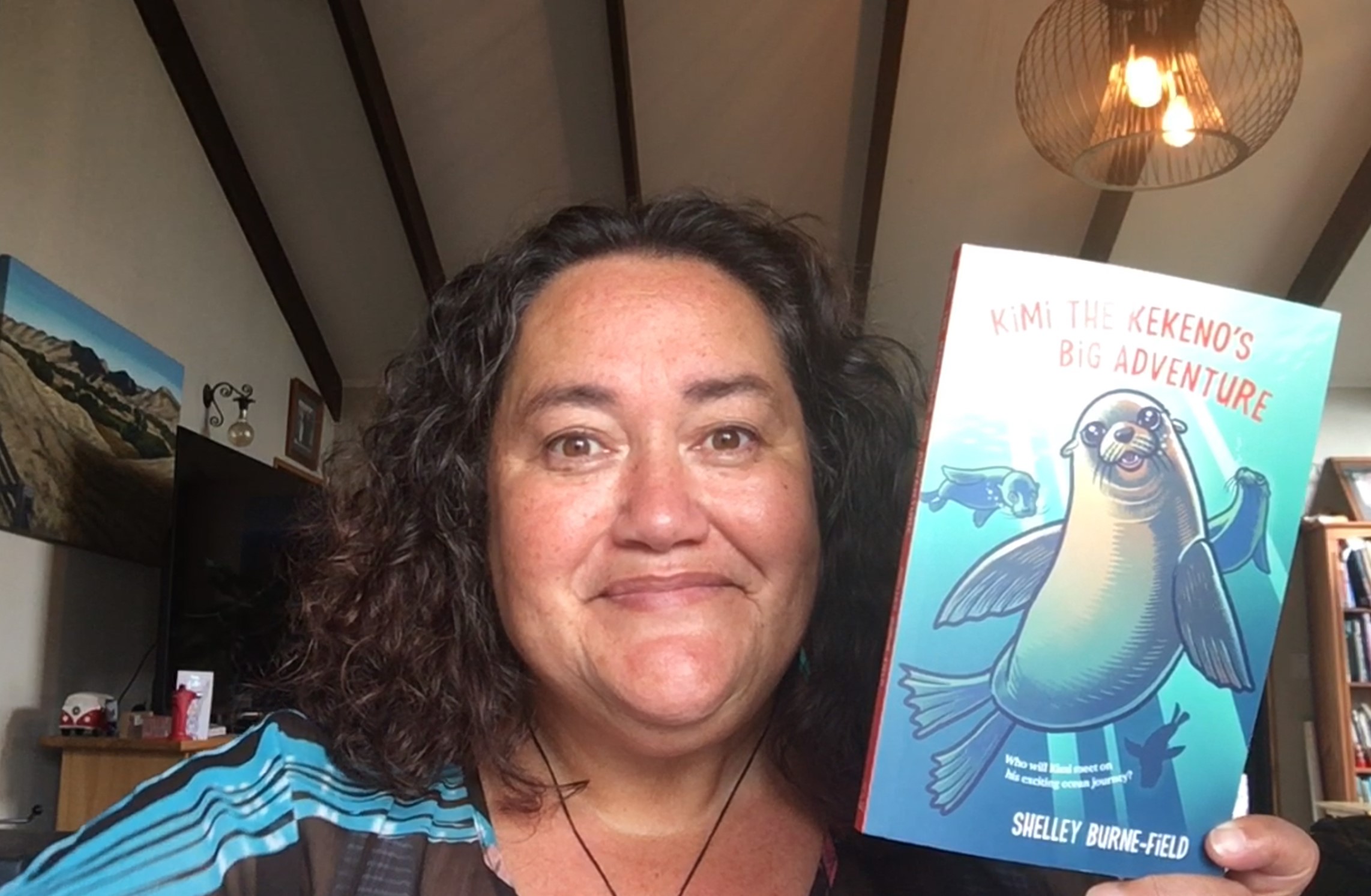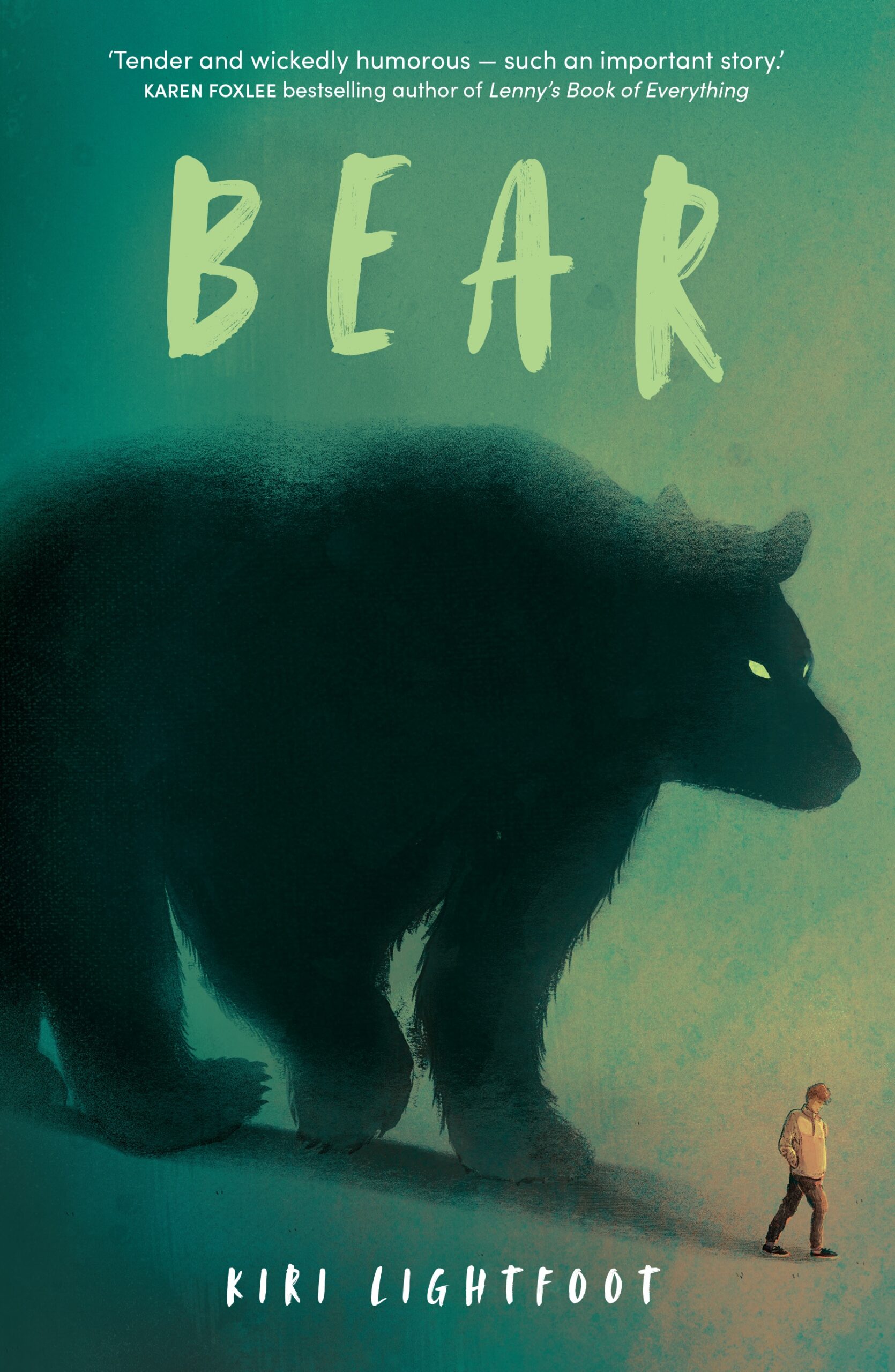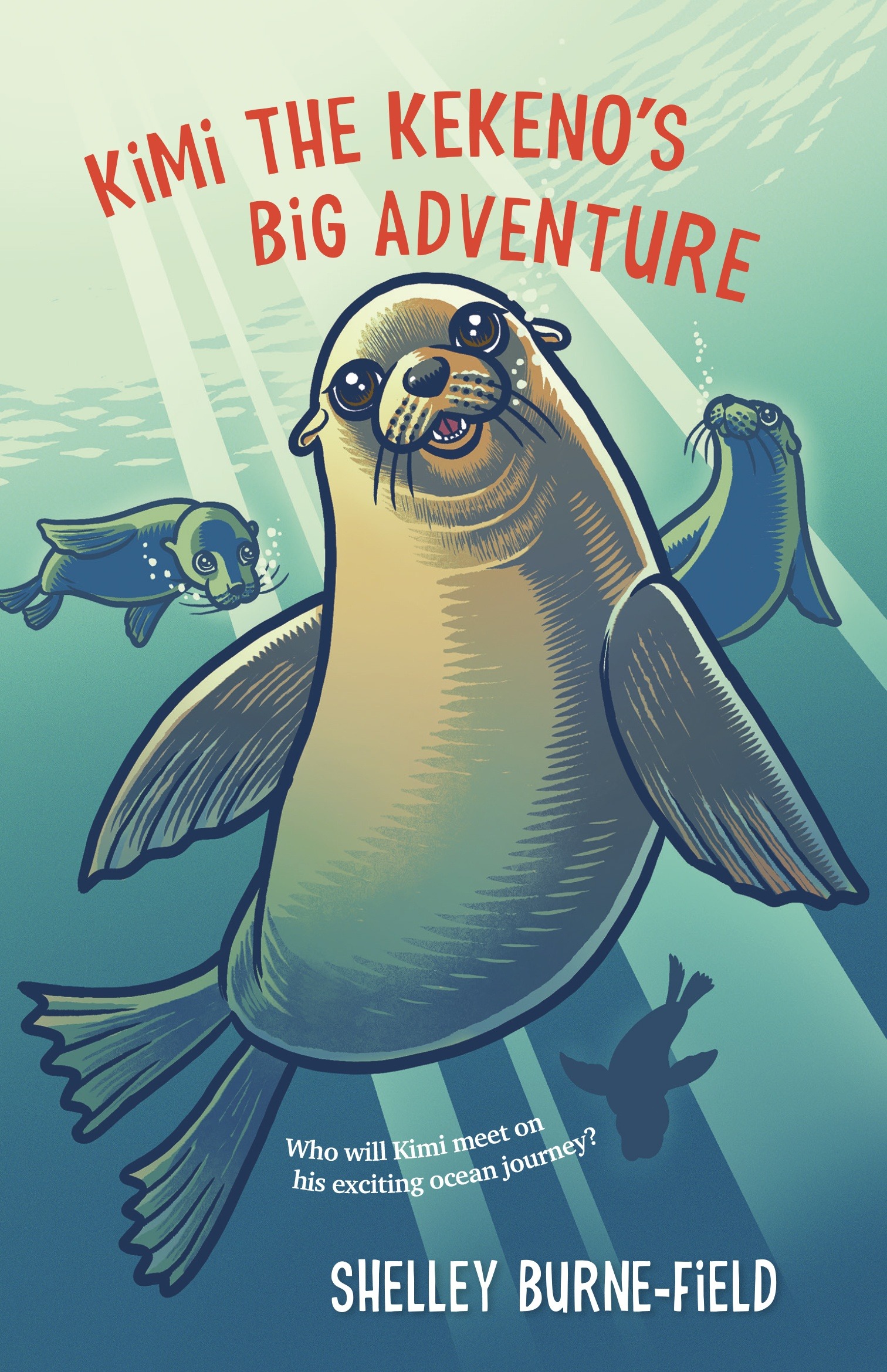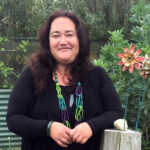Kiri Lightfoot, author of Bear, and Shelley Burne-Field, author of Kimi the Kekeno’s Big Adventure, korero about sources of inspiration, brain blocks and connecting with readers

Shelly Burne-Field (SB-F): I’ve been thinking lately how my brain sometimes stands in the way of my creativity. I try to calm it down with self care, nurturing, and aroha, but it’s tricky. With my writing, I try to get into the flow by letting my wairua come through. Letting my wairua pick up the pen …
Can you comment on what you make of this? What is your flow?
Kiri Lightfoot (KF): Oh, I can totally relate. The biggest hurdle in my creativity is me—my fear that I wont finish, I’m not a good writer, the idea is bad. I need to switch off this part of the brain and stop thinking about outcomes. Especially for the first draft. For me, that needs to be like a release. That is like reconnecting with your wairua, isn’t it? Letting your inner creative come back to life to do the job it’s here to do. I often ask myself, what am I here to say?
SB-F: Āe! Another way of looking at it is, ‘which seat am I sitting in while navigating this life? The mind? The soul?’. That’s what I mean about sitting in the wairua seat … the knowing, the intuition, the trust, listening etc.
KF: Oh absolutely. The flow wasn’t always there with Bear. It was my first novel and took me ten years, and it was those worries that stopped me. It made me not open the document for months at a time. But there was a pull to finish, and I had to come back to that place to do so. It feels magic when you are in it, like there is a greater force at work. For me it’s unnerving at times, I missed school pick-up once because time can seem to disappear. My son was in tears at the school gate and I felt terrible.
I often ask myself, what am I here to say?
I suppose that’s the juggle of being a creative and a parent. At times, I don’t have anything to give, it feels like a big empty space and I’ll never write another decent sentence again. I have to push those thoughts away. When we create, we share our wairua with others, don’t we? The essence of who we are and our connection to the world? And that takes bravery, because when we do, we share a part of ourselves.
SB-F: Āe! It is totes sharing that special something that resonates, that connects with others. It is a feeling like no other. I think when there are those big spaces of nothingness it can mean we are tired. Life can be utterly exhausting. I think I’m learning that things come in their own time. Like our stories, we need to listen to our own advice nē? To love the little things every day. To realise that the sun will shine—it won’t rain every day! To sit in the seat of aroha and imagination and intuition and trust that everything will be okay—and it will.
KF: That’s right, and those ideas do come when we listen for them. I know I just need to wait for them and be ready when they come. That’s what creativity is in a way, isn’t it? The ability to sit in that place. Everyone is capable of it, but some find it harder to switch off that part of the brain. There is a letting go.
SB-F: I love your kōrero about sharing our creativity with others and sharing a part of ourselves. It’s true. I love the fact that we’ve written books and there are readers out there who we’ve connected with. Is this the most fabulous part of being a kaituhituhi [writer], Kiri? How about we never doubt ourselves again, eh? We have something to say, e hoa.
KF: We sure do. Your novels for children are extraordinary adventures set in the animal world, beautifully incorporating the New Zealand landscape and te ao Māori.
How do you choose the animals for your adventures—or do they choose you?
SB-F: They choose me, for sure. We spoke about letting my wairua guide me and this is one of those things. My Aunty gave me a little ceramic kekeno years and years ago. Then one day I saw an article about a kekeno breaking into a house in Mt Maunganui through the cat flap! I looked at that ceramic kekeno and I was like—that’s Kimi. I imagined him meeting in a stone circle under the light of the moon … and there you have it!
… sit in the seat of aroha and imagination and intuition and trust that everything will be okay—and it will
KF: I can’t wait to read it. I loved all the Māori bird names and kupu in Brave Kāhu and the Pōrangi Magpie. It excites me to see te reo Māori being celebrated.
What is your vision for publishing in Aotearoa?
SB-F: I literally couldn’t write that story without kupu. It didn’t feel right for a story set in Aotearoa’s forest and skies to not have Māori words and concepts of te ao Māori. I have a very limited knowledge of te reo Māori. Colonisation meh. I had to learn French at college. One day I hope to be far more proficient at my own language. I’d also like to learn my mother’s language—Sāmoan.
It goes further than just words. For me it was honouring tamariki who aren’t exposed to our reo very often—Māori kids as well as all other ethnicities. I’m really saying, ‘hey! Te reo Māori exists!’, and if a kid has never ever seen or spoken a Māori word in their lives, then here are a few little kupu that you can have fun discovering.

KF: I absolutely agree and this is my hope as well, for publishing, and for tamariki in Aotearoa.
Your next adventure, Kimi the Kekeno’s Big Adventure, is just out—what excitement lies ahead for readers?
SB-F: I love a fantasy adventure. I also love a race or a chase—so Kimi and his mate Rata are racing up the east coast of Te Ika ā Māui, the North Island to a stone circle. These kekeno are young pups experiencing the big ocean for the first time—imagine seeing rocks jutting out from the seabed and swimming and twirling in between them in the silky water, only to be chased by a shark! Along the way they meet some amazing sea creatures like a giant squid and an old kekeno kuia with a missing eye and no teeth! Will they make it and discover their dream in time? Kimi’s adventure is all about dreams.
KF: It sounds beautiful. Can’t wait to read it and be a part of that great chase. Your mid-flight battles in Brave Kāhu blew me away—I felt the wind rushing against my face as I followed Poto’s dips and dives, taking on those angry makipai [magpies]. Give us some insight into how you write those dramatic scenes.
SB-F: Gosh, that’s tricky. I literally imagine being a manu in the sky and play out these scenes in my head! I soar and dive and twirl and peck!
I do have to research certain things too. For example, I had originally written that kāhu can smell different things in the forest but then I learned that kāhu use this sense very rarely. They use their vision much more. Thanks to Debbie Stewart who wrote The Hunters about birds of prey in Aotearoa New Zealand. Her book is so great and informative. Every scrap of information goes into the imagination bank and hopefully makes writing those scenes super special.
I soar and dive and twirl and peck!
KF: I have read that! I went to Wingspan so I could see kāhu, ruru and kārearea up close. It gave me my idea for my next book, I felt those manu had a special message for me.
Do you plan your adventures in advance, or do they unfold as you write?
SB-F: Brave Kāhu was planned in advance. I had whiteboards of scenes and each act, inciting incident, denouement etc … It took me five years of different iterations and drafts to get it right and that was with lots of editor and mentor help—thanks Cassie Hart and Emma Neale!
It was my first book and I’m proud of it but it had its challenges. Kimi the Kekeno’s Big Adventure on the other hand was so easy, but still needed a little help—thanks Kate Grimstock! What does this tell me? Sometimes a plan can lock you into a story that the characters don’t necessarily want to play along with. Not having a plan can bring a sort of flow—for me anyway. It’s different for everyone!
KF: I’m not a planner at all and often think I’m doing something wrong. I haven’t studied creative writing so for me it’s all about following instincts. My partner is a filmmaker and he often asks me about acts, character arcs, tension points and I just shrug. I have a spark of an idea then off I go.
What’s the best piece of advice you’ve been given as an author?
SB-F: Following instincts is vital. It’s that ‘mind/soul’ thing again. Truly, the best advice I’ve been given was by author and Professor Paula Morris who tells every student that only YOU can write the book or story that you want to write. It means that only Kiri Lightfoot could have written Bear. Only Shelley Burne-Field could have written Kimi the Kekeno’s Big Adventure. That stuck with me and it’s what I teach writing students, too. What are your strengths? What are your experiences? What is the story YOU want to writ
What is the story YOU want to write?
KF: Oh, I love that. I felt I was meant to write Bear. My time working in youth health and my love of storytelling came together and it all made sense, the journey I’d been on to write this story.
SB-F: That’s it. It’s magical.
When reading Bear, I bawled my eyes out and laughed so much. The characters and situations are totes real. When I read the lines, ‘I can’t bear it. I can’t bear me’, my heart stopped in my chest. Like, it gave me a cardiac arrest—the wairua connection to being seen and heard was so strong. In those two little lines, you blend everything that Jasper is experiencing in the most unforgettable way. Those lines are magnificent, Kiri. Please share your thoughts of writing stories that resonate with young people, and how you tackle such big subjects.
KF: When I write for young adults, I suppose I’m writing for myself at that age and stories I would have sought out. Those were often stories exploring the gritty bits of being human—the challenges, joys, complex families and relationships. I love characters who are funny, flawed and complex.
As a teenager, I trained to be a counsellor at Youthline and volunteered in youth advocacy. I was particularly passionate about youth mental health as I was aware of the great need to address these issues for young people in Aotearoa. This was the 1990s, and we were still working out how to talk about mental health. I remember feeling like, ‘Come on, let’s talk about this!’.
I thought about this when writing Bear—these emotions are huge. It’s validating to hear about characters experiencing the same complex thoughts. A book can make you feel very seen. I wanted young people to relate to Jasper’s story and his honesty—to hear the story of someone finding a way through darkness into the light.

SB-F: Bear is such a hoot, too. You’re soooo funny—you’ve got that teenage ironic grunge stream of consciousness down pat; that roasting, dissing, meh-ness. It’s so great. You have also captured teenage struggles with mental health in a way I haven’t seen before, and it shows how hard times can become better. Congratulations, e hoa. I think it will be an essential text at secondary schools and libraries for all those precious rangatahi.
What was the hardest thing about being a teenager for you? What do you think has changed for teens these days?
KF: I remember feeling overwhelmed with questions around identity and self worth, and decisions were overwhelming. Who do I want to be in this world? Am I okay as I am? These are the themes I explored in Bear. Family life was always interesting too, and I often write about blended families.
My favourite part of having Bear out in the world now is hearing from young readers. It blows me away, there are so many articulate and thoughtful young people in Aotearoa. And aren’t they lucky there are so many incredible books to choose from? But I know some find it hard, with so many distractions out there, to sit down to read. And that, I suppose, is what’s changed for young people—the pace of life and the immediacy of social media. Books are such a great antidote to all that. A moment of calm for the mind, of connection, and a chance to escape into a good story.

Bear
Kiri Lightfoot
Allen & Unwin
$27.99
Buy now

Kimi the Kekeno’s Big Adventure
Shelley Burne-Field
Allen & Unwin
$19.99
Buy now





